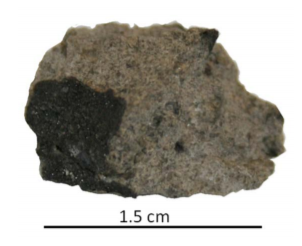Or: Indigenous Organic-Oxidized Fluid Interactions in the
Tissint Mars Meteorite, Jaramillo EA, Royle, SH, Claire MW, Kounaves SP and
Sephton MA. (2019). GRL
Apologies for the clickbait title, it seems as though this
is now compulsory with all space-related scientific writing. I did blow up a
piece of Mars though and I did find stuff out, you can read all about it in a
paper I co-authored which is now published in GRL. Alternatively, here is a
summary, it is massively biased towards the organic geochemistry side of things as that is the bit I did (and the only bit I really understand).
On the 18th July 2011 a meteorite was observed
exploding over the desert in Morocco. Over the following few months fragments
were collected near the village of Tissint, which the meteorite has been named
after. Very few meteorites have actually been found so soon after impact,
usually they have sat around on Earth for many years. In this time they become
contaminated, they sit in dirt, water flows through them and (Earth) microbes make
them their home. Previous studies have shown that the Tissint meteorite is
actually a piece of Mars; Martian igneous rocks that were formed around 600
million years ago were blasted off into space by a large meteorite impact on the surface of that planet around 1 million years ago. This means that the
Tissint meteorite gives us a unique opportunity to explore the geochemical
processes happening in the Martian crust, with the freshest samples we’re going
to get until (if) Mars Sample Return happens.
 |
| the fragment of Tissint used in the study |
Elizabeth, the lead author, had collected samples from the fall
site and analysed them, along with fragments of the meteorite to compare their salt contents as part of her PhD. This had raised a
few questions that needed answering, so I was drafted in to pyrolyze (i.e. flash
heat/blow up) the same samples to see what organic molecules were present and
what they could add to the story.
 |
| Tiny bits of Mars ready for me to grind up and pyrolyze |
As I have mentioned before in my posts, organic does not
equal biological. We were not looking for aliens here, organic molecules are
just those molecules that contain carbon and hydrogen. While they are the ‘building
blocks’ of life, they also form from non-biological process, including in space
and in hot fluid (hydrothermal) systems deep underground. As such they are
common in meteorites and comets and we expect to find them on Mars.
Looking at the organic content had 2 purposes:
1. We wanted to know if the meteorite showed signs of becoming contaminated in the short period of time before it was found (biologically sourced contaminants from Earth-bugs finding their way into the samples would be pretty easy to spot);
2. If no signs of contamination then we hoped to identify actual Martian organic molecules and see what they could tell us about ancient Mars.
1. We wanted to know if the meteorite showed signs of becoming contaminated in the short period of time before it was found (biologically sourced contaminants from Earth-bugs finding their way into the samples would be pretty easy to spot);
2. If no signs of contamination then we hoped to identify actual Martian organic molecules and see what they could tell us about ancient Mars.
Neither the inorganic salt content nor the organic molecular
compositions of Tissint suggested that the meteorite was contaminated (Yay!). While
I detected evidence of microbial life in the soil samples, these hadn’t got
into the meteorite. What I did detect in the meteorite were simple aromatic
(ring-shaped) organic molecules, some of which contained sulphur. This was
quite exciting as these were the same kinds of compounds that have been found
in other Martian meteorites AND on the surface of Mars by the Curiosity Rover.
Suggesting that we had detected actual Marian organic matter!
 | |
|
As the composition of this fluid was similar to seawater
and, there was a readily available source of organic carbon as a food source,
this could have produced a temporarily habitable environment near the surface
of Mars during the late Amazonian period. This is much later than the surface of Mars was potentially habitable and although we don't go as far as saying anything actually lived in it, it could have done....